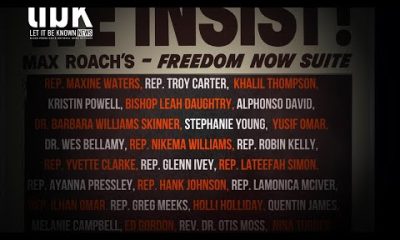Business
Why U.S. Economic Growth Has Disappointed This Year

In this Friday, Feb. 6, 2015 file photo, a shopper pays for produce at a Farmers Market in downtown Los Angeles. Consumers have been uncharacteristically frugal, even as the country added jobs and a sharp drop in gas prices over the past year left them more money to spend. (AP Photo/Richard Vogel, File)
Christopher S. Rugaber, ASSOCIATED PRESS
WASHINGTON (AP) — Like an underachieving student, the U.S. economy isn’t living up to the high hopes it began the year with.
Consumers have been uncharacteristically frugal, even as the country added jobs and a sharp drop in gas prices over the past year left them more money to spend. Meanwhile, drilling companies reeling from cheaper oil have slashed spending much more rapidly than anyone expected.
A host of other, mostly temporary, factors have also weighed on growth. Harsh winter weather kept shoppers at home, and a labor dispute at West Coast ports slowed exports.
Yet hope is still alive for the second half of the year amid signs that the economy could regain lost momentum.
Employers are holding onto their existing workers, keeping layoffs at rock bottom, and adding staff — evidence that their outlook remains positive.
In a report Thursday, the government said applications for unemployment benefits are at the lowest level in 15 years, which means layoffs are low and job security is very high. Employers added 223,000 jobs in April, and the unemployment rate fell to 5.4 percent.
“Companies are implicitly telling us that they believe this is temporary,” says Joseph LaVorgna, an economist at Deutsche Bank. “They’re looking through the weakness from the ports and the weather.”
Indeed, the first half of the year is shaping up to be surprisingly lackluster.
Analysts estimate the economy may expand at an annual rate of just 2 percent in the April-June quarter after barely discernable growth of 0.2 percent in the January-March quarter. Some economists say the government’s next revision will likely send the figure into negative territory, possibly as low as minus 1 percent.
That would put growth in the first half of 2015 at a “pretty disappointing” 0.5 percent, says Michael Feroli, an economist at JPMorgan Chase. That’s a far cry from the 3 percent pace for all of 2015 that most economists expected late last year. Growth hasn’t reached that level since 2005.
The biggest reason behind the disappointment is consumers, who were widely expected to return to their free-spending ways.
Gas prices are still about $1 a gallon cheaper nationwide than a year ago, despite some recent increases. Steady hiring in the past year means 3 million more people are earning paychecks compared with a year ago. And consumer confidence has also risen in recent months.
Yet in the first three months of the year, Americans increased their spending by just 1.9 percent, the weakest gain in a year. A report on restaurant and retail sales Wednesday showed that spending was flat in April, crushing hopes for a stronger rebound.
“The disappearance of consumer spending in early 2015 has now become even more mysterious, as some of the excuses shopped around earlier, like bad weather, are looking more stretched with the passage of time,” Feroli says.
Most economists have concluded that Americans, at least so far, are reluctant to spend their savings from cheaper gas because they believe the drop in prices will be temporary. Meanwhile, spending by oil and gas companies on drilling rigs, steel pipes and other equipment plummeted nearly 50 percent in the first quarter, a much steeper drop than economists forecast.
“We expected (cheaper gas) to have a positive impact,” Paul Ashworth, an economist at Capital Economics, said. “It hasn’t.”
So are things turning around? Short answer: probably.
Many trends currently weighing on growth should fade. International trade will be less of a drag in the second half of the year, economists say. The dollar’s rise against other major currencies, such as the euro, has leveled off. A strong dollar has made exports more expensive, hurting sales in overseas markets.
A surge of imports in March, which widened the trade gap and cut growth, was probably a one-time event triggered by the resolution of the West Coast port dispute.
Consumer spending should rebound from the first quarter’s unusually low level. And spending by energy companies will likely stop falling by the third quarter, LaVorgna said. He expects growth will reach a 3 percent annual rate in the second half.
Home construction is also poised to lift growth. Harsh weather postponed many projects in January and February, but homebuilding rose 2 percent in March from the previous month.
Steady job gains will also help, giving more Americans paychecks that they will ideally spend.
___
Contact Chris Rugaber on Twitter at http://Twitter.com/ChrisRugaber
Copyright 2015 The Associated Press. All rights reserved. This material may not be published, broadcast, rewritten or redistributed.
###
Activism
OPINION: Your Voice and Vote Impact the Quality of Your Health Care
One of the most dangerous developments we’re seeing now? Deep federal cuts are being proposed to Medicaid, the life-saving health insurance program that covers nearly 80 million lower-income individuals nationwide. That is approximately 15 million Californians and about 1 million of the state’s nearly 3 million Black Californians who are at risk of losing their healthcare.

By Rhonda M. Smith, Special to California Black Media Partners
Shortly after last year’s election, I hopped into a Lyft and struck up a conversation with the driver. As we talked, the topic inevitably turned to politics. He confidently told me that he didn’t vote — not because he supported Donald Trump, but because he didn’t like Kamala Harris’ résumé. When I asked what exactly he didn’t like, he couldn’t specifically articulate his dislike or point to anything specific. In his words, he “just didn’t like her résumé.”
That moment really hit hard for me. As a Black woman, I’ve lived through enough election cycles to recognize how often uncertainty, misinformation, or political apathy keep people from voting, especially Black voters whose voices are historically left out of the conversation and whose health, economic security, and opportunities are directly impacted by the individual elected to office, and the legislative branches and political parties that push forth their agenda.
That conversation with the Lyft driver reflects a troubling surge in fear-driven politics across our country. We’ve seen White House executive orders gut federal programs meant to help our most vulnerable populations and policies that systematically exclude or harm Black and underserved communities.
One of the most dangerous developments we’re seeing now? Deep federal cuts are being proposed to Medicaid, the life-saving health insurance program that covers nearly 80 million lower-income individuals nationwide. That is approximately 15 million Californians and about 1 million of the state’s nearly 3 million Black Californians who are at risk of losing their healthcare.
Medicaid, called Medi-Cal in California, doesn’t just cover care. It protects individuals and families from medical debt, keeps rural hospitals open, creates jobs, and helps our communities thrive. Simply put; Medicaid is a lifeline for 1 in 5 Black Americans. For many, it’s the only thing standing between them and a medical emergency they can’t afford, especially with the skyrocketing costs of health care. The proposed cuts mean up to 7.2 million Black Americans could lose their healthcare coverage, making it harder for them to receive timely, life-saving care. Cuts to Medicaid would also result in fewer prenatal visits, delayed cancer screenings, unfilled prescriptions, and closures of community clinics. When healthcare is inaccessible or unaffordable, it doesn’t just harm individuals, it weakens entire communities and widens inequities.
The reality is Black Americans already face disproportionately higher rates of poorer health outcomes. Our life expectancy is nearly five years shorter in comparison to White Americans. Black pregnant people are 3.6 times more likely to die during pregnancy or postpartum than their white counterparts.
These policies don’t happen in a vacuum. They are determined by who holds power and who shows up to vote. Showing up amplifies our voices. Taking action and exercising our right to vote is how we express our power.
I urge you to start today. Call your representatives, on both sides of the aisle, and demand they protect Medicaid (Medi-Cal), the Affordable Care Act (Covered CA), and access to food assistance programs, maternal health resources, mental health services, and protect our basic freedoms and human rights. Stay informed, talk to your neighbors and register to vote.
About the Author
Rhonda M. Smith is the Executive Director of the California Black Health Network, a statewide nonprofit dedicated to advancing health equity for all Black Californians.
Black History
Henry Blair, the Second African American to Obtain a Patent
Being a successful farmer required consistent production. Blair figured out a way to increase his harvest. He did this with two inventions. His first invention was a corn planter. The planter had the same structure as a wheelbarrow, with a box to hold the seed and rakes dragging behind to cover them. This machine allowed farmers to plant their crops more economically.

By Tamara Shiloh
The debate over whether enslaved African Americans could receive U.S. Government-issued patents was still unfolding when the second African American to hold a patent, Henry Blair, received his first patent in 1834.
The first African American to receive a patent was Thomas Jennings in 1821 for his discovery of a process called dry scouring, also known as dry cleaning.
Blair was born in Glen Ross, Maryland, in 1807. He was an African American farmer who received two patents. Each patent was designed to help increase agricultural productivity.
There is very little information about his life prior to the inventions. It is known that he was a farmer who invented machines to help with planting and harvesting crops. There is no written evidence that he was a slave.
However, it is apparent that he was a businessman.
Being a successful farmer required consistent production. Blair figured out a way to increase his harvest. He did this with two inventions. His first invention was a corn planter. The planter had the same structure as a wheelbarrow, with a box to hold the seed and rakes dragging behind to cover them. This machine allowed farmers to plant their crops more economically.
Blair could not write. As a result of his illiteracy, he signed the patent with an “X”. He received his first patent for the corn planter on Oct. 14, 1834.
Two years later, taking advantage of the boost in the cotton industry, he received his second patent. This time for a cotton planter. This machine worked by splitting the ground with two shovel-like blades that were pulled along by a horse. A wheel-driven cylinder behind the blades placed seeds into the freshly plowed ground. Not only was this another economical and efficient machine. It also helped with controlling weeds and put the seeds in the ground quickly Henry Blair received his second patent on Aug. 31, 1836
During this time, the United States government passed a law that allowed patents to be granted to both free and enslaved men. However, in 1857, this law was contested by a slaveowner. He argued that slaveowners had a right to claim credit for a slave’s inventions. His argument was that since an owner’s slaves were his property, anything that a slave owned was the property of the owner also.
In 1858 the law changed, and patents were no longer given to slaves. However, the law changed again in 1871 after the Civil War. The patent law was revised to permit all American men, regardless of race, the right to patent their inventions.
Blair died in 1860.
Bo Tefu
Gov. Newsom Highlights Record-Breaking Tourism Revenue, Warns of Economic Threats from Federal Policies
“California dominates as a premier destination for travelers throughout the nation and around the globe,” said Newsom. “With diverse landscapes, top-rate attractions, and welcoming communities, California welcomes millions of visitors every year. We also recognize that our state’s progress is threatened by the economic impacts of this federal administration, and are committed to working to protect jobs and ensure all Californians benefit from a thriving tourism industry.”

By Bo Tefu, California Black Media
Last week, Gov. Gavin Newsom, along with the nonprofit organization Visit California, announced that tourism spending in California reached a record $157.3 billion in 2024, reinforcing the state’s status as the top travel destination in the United States.
The Governor made the announcement May 5, referencing Visit California’s 2024 Economic Impact Report, which highlights a 3% increase in tourism revenue over the previous year.
According to the report, California’s tourism sector supported 1.2 million jobs, generated $12.6 billion in state and local tax revenues, and created 24,000 new jobs in 2024.
“California dominates as a premier destination for travelers throughout the nation and around the globe,” said Newsom. “With diverse landscapes, top-rate attractions, and welcoming communities, California welcomes millions of visitors every year. We also recognize that our state’s progress is threatened by the economic impacts of this federal administration, and are committed to working to protect jobs and ensure all Californians benefit from a thriving tourism industry.”
Despite the gains in tourism revenue, Visit California’s revised 2025 forecast points to a 1% decline in total visitation and a 9.2% decrease in international travel. The downturn is attributed to federal economic policy and what officials are calling an impending “Trump Slump,” caused by waning global interest in traveling to the United States.
To offset projected losses, the Governor is encouraging Californians to continue traveling within the state and has launched a new campaign aimed at Canadian travelers.
-

 Activism4 weeks ago
Activism4 weeks agoAI Is Reshaping Black Healthcare: Promise, Peril, and the Push for Improved Results in California
-

 Activism4 weeks ago
Activism4 weeks agoBarbara Lee Accepts Victory With “Responsibility, Humility and Love”
-

 Activism4 weeks ago
Activism4 weeks agoESSAY: Technology and Medicine, a Primary Care Point of View
-

 Activism4 weeks ago
Activism4 weeks agoNewsom Fights Back as AmeriCorps Shutdown Threatens Vital Services in Black Communities
-

 Activism4 weeks ago
Activism4 weeks agoFaces Around the Bay: Author Karen Lewis Took the ‘Detour to Straight Street’
-

 Arts and Culture4 weeks ago
Arts and Culture4 weeks agoBOOK REVIEW: Love, Rita: An American Story of Sisterhood, Joy, Loss, and Legacy
-

 #NNPA BlackPress4 weeks ago
#NNPA BlackPress4 weeks agoThe RESISTANCE – FREEDOM NOW
-

 Alameda County4 weeks ago
Alameda County4 weeks agoOUSD Supt. Chief Kyla Johnson-Trammell to Step Down on July 1



















































